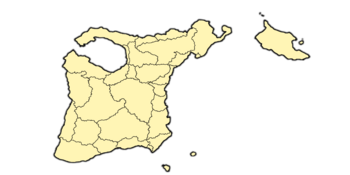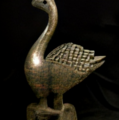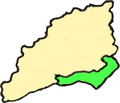Lankterlerp
the Kingdom of Lankterlerp Kúngeriket Lankterlerp, Kungsinrike Lankeserp | |
|---|---|
| Motto: Dó somm kujon, eller dó for lantet! Die like a coward, or die for the country! | |
| Anthem: Hvór jeg vik leva Royal anthem: For Kúnge okk hans liv! | |
 Map of Lankterlerp | |
 Map of Lankterlerp w/ Provinces | |
| Status | Independent |
| Capital | Úrslot |
| Largest | Kjenstad |
| Official languages | Norish |
| Recognised regional languages | Kurzi |
| Ethnic groups | 92% Norish, 7% Kurz, 1% Others |
| Religion | Norish Christianity, Catholicism, Protestantism |
| Demonym(s) | Lankterlerpain, Norish |
| Government | Constitutional Monarchy, Social Democracy |
• Monarch | King Haakon III |
• Prime Minister | Louise Ákan |
| Legislature | Hultstinget |
| House of Storkarls | |
| House of Smaakarls | |
| Establishment | |
• Juvias's Expedition | 805 |
• Perian Wars | 981 |
| Population | |
• 2019 estimate | 61,000,000 |
| GDP (PPP) | 2019 estimate |
• Total | 370 Billion USD |
• Per capita | 285 Billion USD |
| GDP (nominal) | estimate |
• Total | 372 Billion USD |
| Gini (2019) | 33 medium |
| HDI (2019) | 0.976 very high |
| Currency | Perian Krone (PEK) |
| Time zone | LST (Lankterlerpian Standard time, 10 minutes more than UTC+1) |
| Driving side | right |
| Calling code | +745 |
| Internet TLD | .LA |
Lankterlerp, officially the Kingdom of Lankterlerp (Norish: Kúngeriket Lankterlerp, Kurzi: Kungsinrike Lankeserp), is a nation located in southern Thrismari, and borders the nations of East Alyeska, Hiblund, Frarstizk, and Bro Wyned. Counting sea borders, it also borders Etheria Roshni. Recently, there have been talks for the eastern most island, the home of the Kurzi people, and Lankterlerp to form an official union, where as right now Kurzi only holds autonomy. The name of which would be the Norish Realm, however talks are still ongoing, and it is only a concept.
An industrialised exporter of agricultural produce in the second half of the 19th century, Lankterlerp introduced social and labour-market reforms in the early 20th century, which formed the basis for the present welfare state model and advanced mixed economy.
Lankterlerp is a highly developed country. with a high standard of living: the country performs at high measures of education, health care, civil liberties, democratic governance and LGBTQ rights. Lankterlerp maintains close political, cultural, and linguistic ties with its neighbours, with Norish being partially mutually intelligible with parts of Frarstizk, and Etheria Roshni.
Also, their national animal is the Crowned Swan.
Etymology
The etymology of the name "Lankterlerp", the relationship between "Norish" and "Lankterlerp", and the emergence of Lankterlerp as a unified kingdom are topics of continuous scholarly debate. Mainly the part where the Norish still refer to themselves as Norish, and not Lankterlerpian. However, its likely just to salute their ancestors.
Also, the name Lankterlerp is based on the name of the Duchy of Lanker, which was the leading Duchy in the Norish Confederation. After the Perian wars, Lankterlerp, as a last sign of victory, took the Perian word for "leap", which was lerp. He also borrowed another word, "glora", which meant "glory", and called his Kingdom "Lankerlerpglora", literally "Lanker leaps for glory". Since then, it's been modernized to its modern name.
Prehistory
Not much is known about history before the Norish showed up, however it is known that multiple Germanic tribes had been in the area since 8,000 BC, as small pieces of germanic-based bronze coins that were scattered all over modern-day Lankterlerp. There was also found evidence that a pre-historic Kurzish tribe was in the area, directly west of the island they inhabit, historians therefore believe that the Germanic tribes kicked them out and forced them onto the island early on in their history. However, like much of their history, it is only speculation.
Medieval History
Lankterlerp's earliest history (that we know of) started with Juvias's Expedition, where he lead Norish tribes from their ancestral home to the south, it is unknown why, but theories have been going around about potential competition in the area. Either way, in about 805 the began to march, evident by the classic
[1]Swan figurines, which is still in-use today as a ritualistic item, and carried by all Royal Marine Corps in the country. After the arrival of the Norish, a lot more history starts being writen down, especially by the Perian Kingdom, a confederation of city states on the coast of much of modern-day Lankterlerp. Peria was Germanic, so it was very likely that the pre-historic area was, in fact, Germanic.
Perian Wars
First Perian War
981-988
After about 170 years of continued peace, the rich Perian lands started being too good to be overlooked by the gold hungry Lankterlerpians, who by now was split into 7 tribes, Ruff, Sjkal, Tumer, Pérr, Keljing, Vidgodt, And Dakk, who was the only one who had a coast.
Despite their differences, they all wanted one thing; Gold, riches, and land. And so, in 979, they formed a federation, and 2 years later, they attacked Peria.
The Norish tribes had around 30.000 men in their army, whilst Peria had 18.000, however it is important to note that Peria was much richer and better organized than the Tribes, and therefore would see many victories and close victories in the war. The first war would last about 7 years, and resulted in 2 counties to the Norish tribes, and a truce for 20 years.
Second Perian War
988-1005
After only 17 years after the conflict, the Norish and Perians found themselves at war yet again, however not much is known about this war, due to the burning of the Jervs Library, which is most that is known. It ended in a stalemate.
Third Perian War
1011-1032
After 6 years after the second conflict, a Third and better documented war came about, due to a mutual agreement that no important buildings would be destroyed. Before going deeper into it, it is important to note that the Norish tribes had officially banded together as a confederal monarchy, lead by the 3 newly conquered territories, which had formed the Kingdom of Lank, which ruled over all the smaller states. The war started when a Norish army, lead by King Julvind, invaded northern Peria, but struggled to make quick progress, as the forest there were excellent for defenders. Meanwhile, a Perian army of about 7.000 men began invading the western coast of the confederation, struggling from the same conditions as the Perian army from the north. However, the reasn why the Norish were so succesful to begin with, was due to their lack of care for nature or animals, and so began burning the trees, starting a forest fire which would destroy Perian crops, but also backfired when a fire erupted in some of the Norish settlements. But, it did clear the way, and now a Norish army of 13.000 was heading towards the Perian capital of Keners. An army of 15.000 Perians stopped them at the Battle of Kelvind, and both sides began bringing in reinforcements, with 20.000 Norish and 19.000 Perians, the 2nd Battle of Kelvind lasted 5 days, and ended when Norish spies managed to sneak into the Perian camps at night and slaughtering 800 people, including 70 nobles, the next morning the remaining forces scattered. With so much of their army devastated, Peria sued for peace. The war lasted a gruesome 22 years.
Fourth Perian War
1037-1038
After 5 years after the Third war, the fourth and last Perian war began. It was essentially just Lankterlerp beating up a corpse as the exhausted perians could only offer 7.000 troops, while Lankterlerp had already prepared an army of 20.000 men, and after 5 months of fighting, Kyen, (Modern day Kjenstad) fell to a Lankterlerpian siege. After this, Peria was completely annexed, and Kjenstad held up their legacy by being the largest city in Lankterlerp today. Also, at Kjenstad cathedral, the Norish leaders came together to proclaim a single united state, with all families from all the duchies just being regular feudal lords, while the leading duke in Lanker became a king.
Great Expeditions
Great Western Expedition
1061-1121
After the Perian Wars, Lankterlerp was exhausted, and the forest fire started in the Third Perian War would take 200 years to fully end, resulting in mass famines in most of the medieval period. However, this did not stop them from expanding west, mostly encouraged by the ongoing forest fire in the east.
Early Modern History(1500-1842)
Constitutional Monarchy (1842-Present)
- ↑ File:Swan Figure.png





